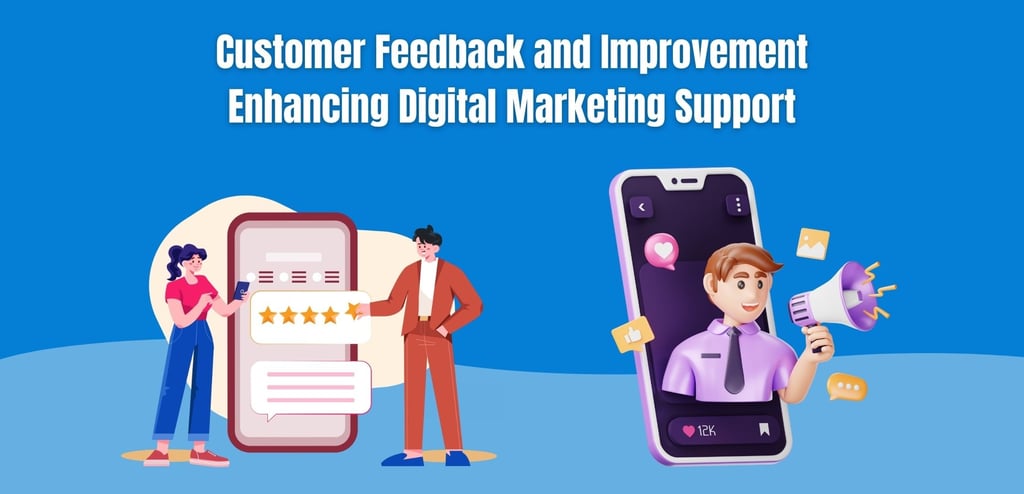
Customer Feedback and Improvement Enhancing Digital Marketing Support
By AZ Konnect Team
12/5/20246 min read


In today’s digital age, customer feedback has become a cornerstone for businesses looking to improve their digital marketing efforts. As companies navigate the competitive online landscape, listening to customer feedback and implementing changes based on those insights is no longer optional—it’s essential for staying ahead. Whether it’s through social media, surveys, reviews, or direct customer interactions, feedback offers invaluable data to fine-tune marketing strategies, improve customer experience, and foster long-term brand loyalty.
In this blog post, we’ll explore the importance of customer feedback in enhancing digital marketing support, along with actionable strategies for collecting and using feedback to improve your marketing performance.
1. Why Customer Feedback is Vital for Digital Marketing
Customer feedback provides direct insight into how your audience perceives your brand, products, services, and digital marketing campaigns. Unlike assumptions or internal metrics, customer feedback reflects real experiences and expectations, helping you address the needs and desires of your audience more effectively.
Key Benefits of Customer Feedback:
Tailored Marketing Strategies:
Feedback helps you understand what resonates with your audience, allowing you to customize content, offers, and messaging based on actual preferences.
Improved Customer Experience:
Listening to your customers and addressing their concerns shows that you value their input, leading to higher satisfaction and loyalty.
Identifying Gaps and Opportunities:
Feedback can reveal areas where your digital marketing might be falling short, giving you the opportunity to improve and uncover new ways to engage your audience.
Building Trust:
Acting on customer feedback demonstrates that you are a brand that listens and cares, which builds trust and strengthens your relationship with customers.
2. Collecting Customer Feedback Through Digital Channels
To make the most of customer feedback, businesses need to establish efficient ways to gather and analyze insights. Thankfully, digital marketing channels provide a wealth of opportunities to collect customer feedback, each offering unique advantages depending on your business goals and target audience.
Actionable Methods for Gathering Feedback:
Social Media Monitoring:
Platforms like Twitter, Instagram, and Facebook are prime spaces for understanding customer sentiment. Monitor comments, mentions, and direct messages to get an unfiltered view of customer experiences.
Surveys and Polls:
Send out brief surveys through email marketing campaigns or pop-up forms on your website. Make it easy for customers to share their opinions by keeping surveys short and focused on key areas of your business.
Online Reviews and Testimonials:
Encourage customers to leave reviews on platforms like Google, Yelp, or Trustpilot. Reviews offer honest feedback and can highlight areas for improvement in both your products and marketing.
Email Feedback:
After a customer makes a purchase or interacts with your business, follow up with a personalized email asking for feedback on their experience. This can provide deeper insights into specific touchpoints within the customer journey.
Chatbots and Live Chat:
Use chatbots or live chat features on your website to collect real-time feedback from users as they browse or interact with your digital content. Many customers are more likely to share their thoughts if prompted directly during their visit.
Net Promoter Score (NPS):
This metric measures customer loyalty by asking how likely they are to recommend your product or service to others. The simplicity of NPS surveys makes them easy to implement, providing a snapshot of overall customer satisfaction.
3. Leveraging Feedback to Improve Digital Marketing Strategies
Once you’ve gathered customer feedback, the next step is to use this valuable data to refine and improve your digital marketing strategies. Every piece of feedback—positive or negative—offers insights that can guide changes to your campaigns, content, and customer engagement.
Actionable Ways to Implement Feedback:
Content Personalization:
Use feedback to personalize your content marketing efforts. If customers are expressing interest in specific topics, create blog posts, videos, or social media content that addresses those interests. Personalized content makes customers feel seen and understood.
Targeted Advertising:
If feedback highlights that a certain demographic responds well to your product or service, refine your digital ad targeting to focus more heavily on that audience. By understanding which groups are most receptive, you can allocate your advertising budget more efficiently.
Enhance Customer Support:
Feedback about challenges or friction points in the customer experience can guide improvements in your customer support system. If customers mention long wait times for responses or confusion about services, invest in live chat support or a more user-friendly FAQ page.
Product Development and Innovation:
If customers are suggesting new features, product enhancements, or updates, feed this information back into your product development process. Marketing and product teams should collaborate to ensure that customer preferences shape both product offerings and promotional efforts.
SEO and User Experience Optimization:
Use feedback related to website usability, content structure, and overall experience to improve your site’s search engine optimization (SEO) and user experience (UX). For example, if users struggle to find information or navigate your site, streamline the layout and add clear calls-to-action.
Optimize Email Campaigns:
Analyze feedback from your email marketing campaigns, such as open rates, click-through rates, and direct feedback from recipients. Use this data to optimize email timing, subject lines, and content to better engage your audience.
4. Closing the Feedback Loop: Following Up with Customers
One of the most important aspects of utilizing customer feedback is following up. When customers take the time to provide insights, they want to know their voices are heard and valued. Closing the feedback loop shows customers that their opinions matter and builds trust in your brand.
Actionable Follow-Up Strategies:
Acknowledge Feedback:
Whether positive or negative, always acknowledge customer feedback. A simple thank you message or response to a review can go a long way in building goodwill and showing appreciation.
Communicate Changes:
If feedback leads to changes in your business or marketing strategies, communicate this to your customers. Use email newsletters, blog posts, or social media to announce improvements and let your audience know that their feedback played a key role.
Reward Customer Input:
Offering small incentives such as discounts, exclusive content, or loyalty points in exchange for feedback can encourage more customers to share their opinions. Rewards also show appreciation for their time and effort.
Provide Transparency:
Be transparent about how you’re using customer feedback to guide decisions. Transparency fosters trust and can help improve relationships with your audience over the long term.
5. Using Negative Feedback as a Growth Opportunity
Negative feedback may feel discouraging, but it’s one of the most valuable tools for growth. Constructive criticism offers opportunities to address weaknesses and build stronger, more customer-centric digital marketing strategies.
Actionable Ways to Address Negative Feedback:
Respond Promptly and Professionally:
When receiving negative reviews or feedback, always respond promptly and professionally. Acknowledge the issue, offer a solution, and ensure the customer feels heard. Public responses also show potential customers how your brand handles criticism.
Identify Common Pain Points:
Look for patterns in negative feedback. If multiple customers are expressing frustration with the same issue, it’s likely a systemic problem that needs addressing in your digital marketing, product, or service delivery.
Turn Criticism into Positive Engagement:
Negative feedback can be an opportunity to turn an unhappy customer into a loyal advocate. By resolving their issue quickly and effectively, you can transform a negative experience into a positive one, earning long-term customer loyalty.
6. The Role of Data Analytics in Feedback Utilization
Incorporating data analytics alongside customer feedback can help you gain a more comprehensive understanding of how your digital marketing efforts are performing. While feedback provides qualitative insights, data analytics offers the quantitative aspect that shows trends, behaviors, and patterns.
Actionable Solutions for Merging Data with Feedback:
Integrate Customer Feedback Tools with Analytics Platforms:
Use platforms like Google Analytics, HubSpot, or other marketing tools to integrate feedback data with website performance metrics, social media engagement, and email campaign results. This allows you to see how customer insights align with actual behavior.
Track Key Performance Indicators (KPIs):
Use feedback to identify which KPIs are most relevant to your customers. For example, if feedback consistently mentions slow page load times, you can prioritize improving this metric in your analytics strategy.
A/B Testing Based on Feedback:
If feedback suggests that certain headlines, CTAs, or ad copy resonate better with your audience, conduct A/B testing to refine and optimize your content based on these insights.
Conclusion
Customer feedback is one of the most powerful tools for businesses looking to enhance their digital marketing support. By actively listening to your audience, gathering actionable insights, and making data-driven improvements, you can create more personalized, engaging, and successful marketing campaigns. Remember, customer feedback is not just a one-time data point—it’s an ongoing dialogue that helps businesses evolve and stay aligned with the needs and desires of their audience.
Ultimately, by valuing and acting on customer feedback, you create a customer-centric brand that is not only responsive to its audience but also primed for continuous growth and success in the digital marketplace.
Subscribe To Our Newsletter


